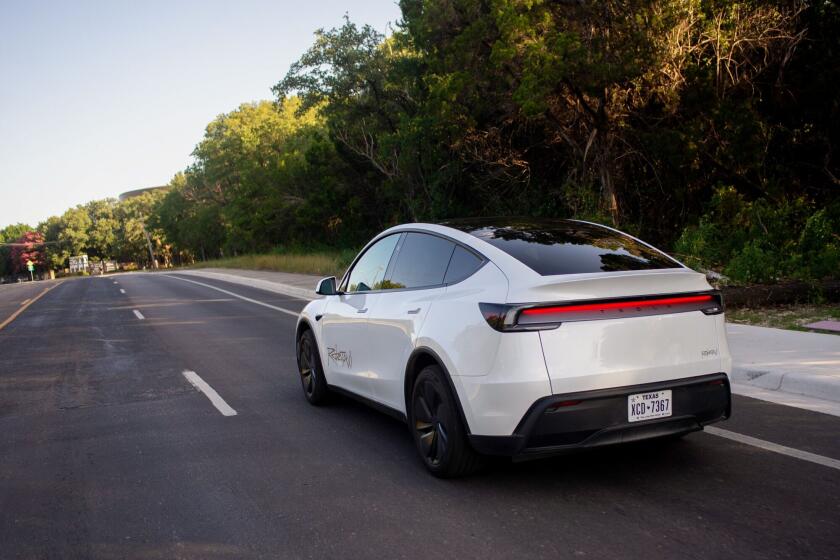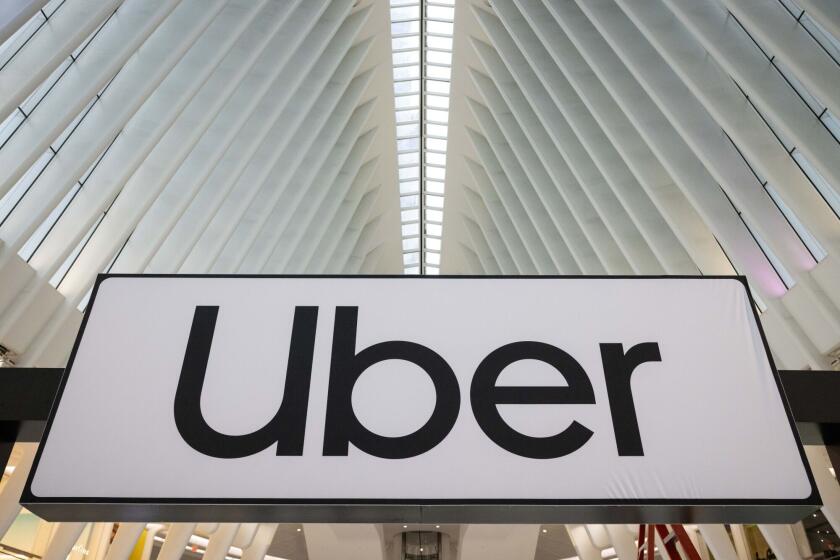Smog Cops to Look for Emissions of Guilt
- Share via
For anyone who has ever been stuck behind a car belching thick black plumes of pollution, Southern California’s smog cops have a message that some will find reassuring: They will soon be scanning the streets for smoky clunkers.
In the largest experiment of its kind in California, the South Coast Air Quality Management District plans to use remote sensors and video cameras to measure air pollution from 1 million vehicles as they enter freeways and navigate roads in the counties of Los Angeles, Orange, San Bernardino and Riverside.
For the record:
12:00 a.m. Aug. 18, 2005 For The Record
Los Angeles Times Thursday August 18, 2005 Home Edition Main News Part A Page 2 Foreign Desk 2 inches; 89 words Type of Material: Correction
Smog checks -- An article in Sunday’s Section A said “cars built in 1976 or before are exempt” from the state’s smog-check program. That is no longer true under a state law that took effect April 1. Vehicles built in 1976 that were registered before April 1 did not have to get a smog check this year but will have to in the future. Vehicles built in 1976 and registered after April 1 have to get a smog check. Vehicles from the 1975 model year and earlier are exempt.
If caught, the owners of the most environmentally offensive cars and trucks would receive letters informing them that the government would pay to fix or scrap their vehicles. The South Coast district estimates that 10,000 to 20,000 of the dirtiest vehicles would be detected. Smog regulators lack the authority to order drivers to dump dirty cars, but they can offer incentives.
California officials estimate that the dirtiest 10% of all cars and trucks -- mostly older vehicles -- spew out roughly 50% of the state’s smog-forming emissions from vehicles. By the end of this decade, three-fourths of emissions from vehicles will be from older cars and trucks, state officials estimate.
Studies have shown that scrapping high-polluting vehicles is among the most cost-effective ways of cleaning the air -- far cheaper than additional controls on power plants and refineries. Yet politicians and state officials have failed for years to get the dirtiest cars off the streets.
“You can’t meet our air quality goals without addressing this problem,” said Victor Weisser, chairman of California’s Inspection and Maintenance Review Committee, which oversees the state’s smog-check program.
“We have made great strides with cleaner gasoline and new engines, but you can’t make bigger reductions until you get some of these cars off the road,” he said. “And unless we do something, these cars from the 1980s are going to be on the road a long time.”
Smog regulators are expected to give formal approval to the program next month, and enough sensors to scan a million cars -- one in 10 cars in Southern California -- would begin work early next year.
Air officials, fearing that motorists with dirty cars would try to avoid the sensors, won’t disclose where they will be, other than saying most will be along freeway ramps. Perhaps as few as a dozen would be required, because each one can scan thousands of vehicles a day, and they will be moved from place to place, officials said.
Past efforts to focus on the dirtiest cars and trucks have been stalled by political opposition. Some opponents have complained that poor families who can least afford new cars would be hurt most by any move to target high-polluting vehicles. Other opponents have raised concerns that sensors would invade people’s privacy.
In an attempt to allay privacy concerns, air pollution officials plan to hire a nonprofit group to send the mailings and deal with vehicle owners. The information on whose cars turned up as high polluters will be maintained in a database separate from motorists’ regular state records, officials said.
Even as local smog regulators are moving ahead with the remote-sensor idea, state air quality officials have doubts about it. Some have questioned the accuracy of remote-sensing equipment, fearing that it will finger the wrong drivers by mistake. Southern California air regulators, by contrast, say the technology, which is now being used in Texas and Maryland, has a good track record.
Some critics of California’s smog-control tactics say the real reason the state has failed to address the problem of dirty, older cars is that doing so would require officials to acknowledge that the smog-check program is not working.
Ten million cars and trucks are tested every year in California to ensure that they do not emit excessive pollution. Cars built in 1976 or before are exempt, as are cars newer than six years old. All other cars must be tested every other year to have vehicle registrations renewed. In most cases, cars that fail must be repaired so they will pass inspection.
A 2001 report by the National Academy of Sciences found smog-check programs generally failed to deliver the predicted pollution reductions, though it noted that they had made a positive impact.
In California, an evaluation of the state program found that in 1999 it was achieving only 36% of the reductions state regulators had predicted. Changes have produced marked improvements, but the program is still falling short of expectations.
“Smog check is like trying to stop drunk driving by giving everyone a sobriety test once a year at the DMV,” said Joel Schwartz, a former executive officer of the committee that oversees the smog-check program and now a visiting scholar with the American Enterprise Institute, a free-market think tank.
“We have known for at least 20 years that these inspection programs do not work particularly well,” Schwartz said. “The evidence has been overwhelming that they are failing to repair the high-polluting cars. There is fraud. And yet they have been popular with regulators and activists.”
The smog-check program has been plagued by fraud since its inception in 1984. In the last decade, state investigations have uncovered dozens of private smog-check stations engaged in “clean piping,” a practice in which emissions from a cleaner vehicle are illegally used to substitute for one that could not pass the inspections. In many cases, investigators have found that smog station technicians charged extra money on the side without the knowledge of a shop’s owners.
Outside reviews of the program, conducted by pulling over motorists after they have received smog checks, have also found evidence of what critics call the “clean for a day” problem: cars that have been rigged by technicians to get through the test, only to fall back into disrepair within days.
“There is a lot of suspicion that the repairs being done” on cars and trucks that fail the smog checks “are not lasting,” said Dean Saito, the official in charge of the planned Southern California monitoring program.
That’s what Douglas R. Lawson, a former scientist with the California Air Resources Board, discovered to his surprise a decade ago.
In 1995, Lawson used sensors to detect high polluters in Orange County and then radioed California Highway Patrol officers to pull over the vehicles and administer smog tests on the spot. More than 90% failed, including many that had recently passed the smog check.
The smog-check program has been reworked numerous times, but large-scale changes have proved politically difficult, in part because the 8,000 private smog-testing stations in the state have become political players in their own right, with lobbying coalitions in Sacramento.
Last year, groups representing smog stations opposed a proposal to grant longer new-car exemptions from inspections, arguing that it would harm their businesses. The proposal involved raising smog-check fees and ultimately provided the money to help fund the new remote-sensing proposal.
Citing smog check’s underperformance, Schwartz and other critics argue that the state should scrap the program or at least limit it to older cars and instead install a vast web of remote sensors to snare problem vehicles.
Most air pollution experts reject that suggestion, arguing that remote sensing alone could never replace smog checks.
But supporters of remote sensing maintain that some state officials have opposed the technology out of fear that the sensors will expose smog check’s flaws.
Lawson is one of several experts who argue that a large-scale monitoring program in California is long overdue.
“I am a fan of getting the air clean at the lowest cost to society, period,” Lawson said. “And I am convinced that if the high-emitter problem were solved, the Los Angeles region would” comply with clean-air standards.
“I am happy that the South Coast is moving forward, they are showing leadership. But this should have been done a decade ago.”
*
(BEGIN TEXT OF INFOBOX)
Finding the dirtiest vehicles
Southern California pollution fighters plan to set up mobile units to find fume-belching vehicles. Owners will be offered money to fix or scrap the cars and light trucks. Here’s how the system will work:
1) Sensors record engine output data and trigger camera to identify license plate and kind of vehicle.
2) Laser beam checks concentration of hydrocarbons and other pollutants in exhaust.
3) Data are later retrieved and notices sent to owners of gross polluters.
*
Key points
Program is expected to begin early next year in Los Angeles, Orange, Riverside and San Bernardino counties.
- Possibly as few as a dozen sensors would be needed to monitor tailpipe emissions, mostly on freeway access ramps.
- Drivers who get notices could go to one of 32 community colleges, where smog-check dispute referees and mechanics would do tests and up to $500 in free repairs.
- Alternatively, the South Coast Air Quality Management District would offer owners $1,000 to scrap clunkers.
- Low-income owners could get up to $2,000 in additional aid to replace older cars with ones built after 1990.
*
Sources: South Coast Air Quality Management District, Taschen.
Graphics reporting by Cheryl Brownstein-Santiago
More to Read
Sign up for Essential California
The most important California stories and recommendations in your inbox every morning.
You may occasionally receive promotional content from the Los Angeles Times.













